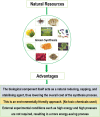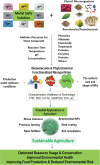Mitigating Global Challenges: Harnessing Green Synthesized Nanomaterials for Sustainable Crop Production Systems
- PMID: 38223890
- PMCID: PMC10784203
- DOI: 10.1002/gch2.202300187
Mitigating Global Challenges: Harnessing Green Synthesized Nanomaterials for Sustainable Crop Production Systems
Abstract
Green nanotechnology, an emerging field, offers economic and social benefits while minimizing environmental impact. Nanoparticles, pivotal in medicine, pharmaceuticals, and agriculture, are now sourced from green plants and microorganisms, overcoming limitations of chemically synthesized ones. In agriculture, these green-made nanoparticles find use in fertilizers, insecticides, pesticides, and fungicides. Nanofertilizers curtail mineral losses, bolster yields, and foster agricultural progress. Their biological production, preferred for environmental friendliness and high purity, is cost-effective and efficient. Biosensors aid early disease detection, ensuring food security and sustainable farming by reducing excessive pesticide use. This eco-friendly approach harnesses natural phytochemicals to boost crop productivity. This review highlights recent strides in green nanotechnology, showcasing how green-synthesized nanomaterials elevate crop quality, combat plant pathogens, and manage diseases and stress. These advancements pave the way for sustainable crop production systems in the future.
Keywords: agriculture; green nanomaterials; nanofertilizer; sustainable crop production.
© 2023 The Authors. Global Challenges published by Wiley‐VCH GmbH.
Conflict of interest statement
The authors declare no conflict of interest.
Figures
References
-
- Rai M., Ingle A., Appl. Microbiol. Biotechnol. 2012, 94, 287. - PubMed
-
- Zhang B., Pinsky B. A., Ananta J. S., Zhao S., Arulkumar S., Wan H., Sahoo M. K., Abeynayake J., Waggoner J. J., Hopes C., Tang M., Dai H., Nat. Med. 2017, 23, 548. - PubMed
-
- Rawtani D., Khatri N., Tyagi S., Pandey G., J. Environ. Manage. 2018, 206, 749. - PubMed
-
- Chaudhry N., Dwivedi S., Chaudhry V., Singh A., Saquib Q., Azam A., Musarrat J., J. Microbial. Pathog. 2018, 123, 196. - PubMed
Publication types
LinkOut - more resources
Full Text Sources





